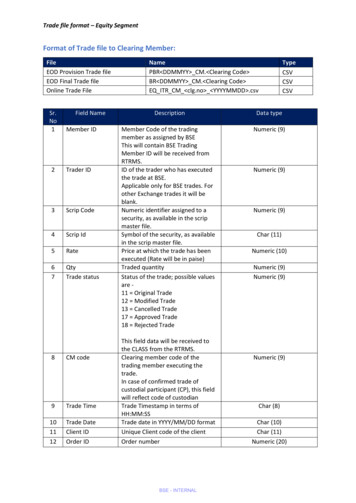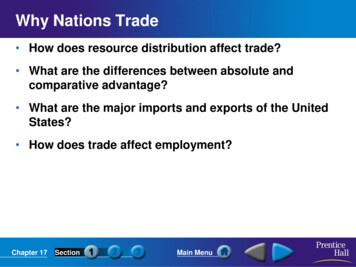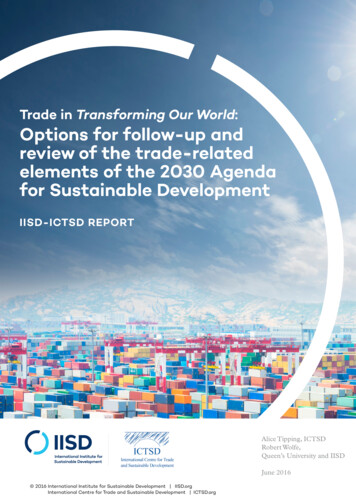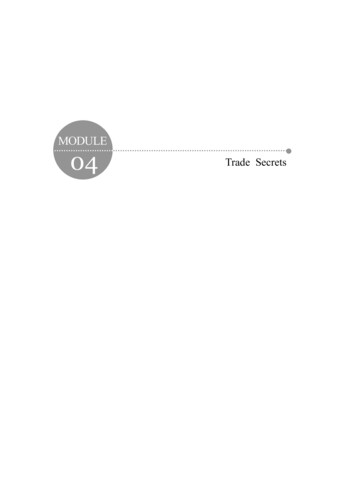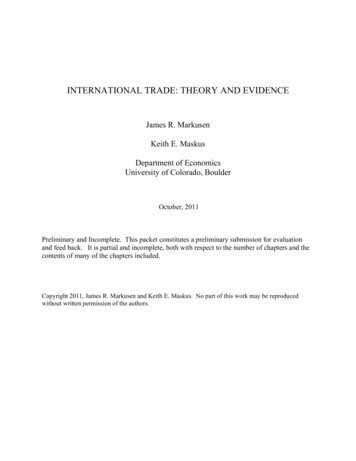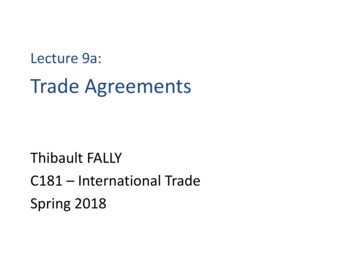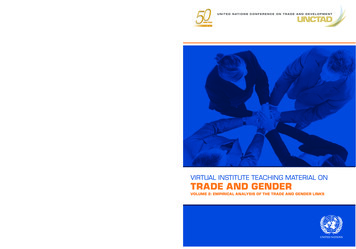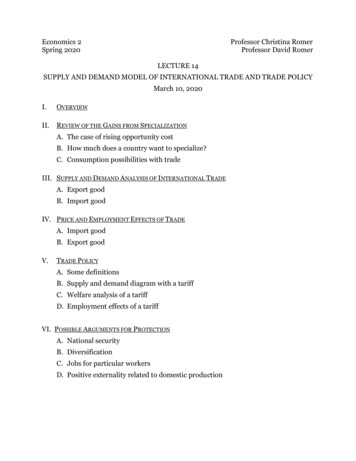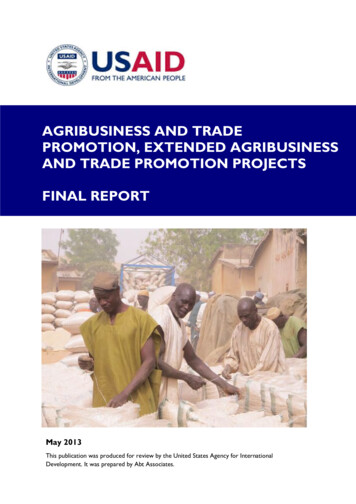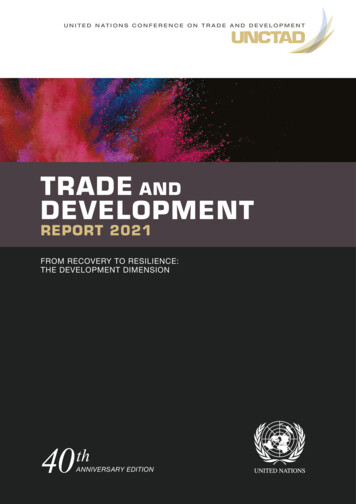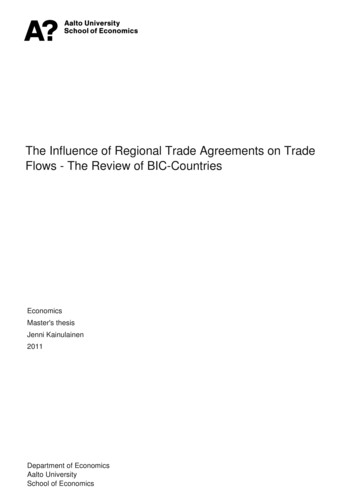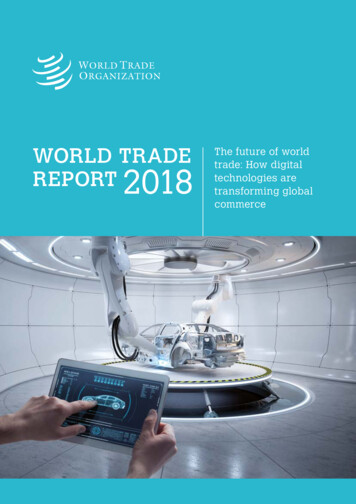
Transcription
WORLD TRADEREPORT2018The future of worldtrade: How digitaltechnologies aretransforming globalcommerce
What is the WorldTrade Report?The World Trade Report is anannual publication that aims todeepen understanding abouttrends in trade, trade policyissues and the multilateraltrading system.What is the 2018Report about?The 2018 World Trade Reportexamines how digitaltechnologies are transformingglobal commerce. It considersthe different ways in whichdigital technologies affectinternational trade and theextent of potential forthcomingchanges, and discusses theconsequences of thistransformation for existing andfuture international tradecooperation.Find out moreWebsite: www.wto.orgGeneral enquiries:enquiries@wto.orgTel: 41 (0)22 739 51 11
CONTENTSContentsAcknowledgements and Disclaimer2Foreword by the WTO Director-General3Key facts and findings5Executive summary6A. Introduction1. Technological innovations have shaped global trade14162. A new world in the making193. Structure of the report20B. Towards a new digital era221. The rise of digital technologies242. How much digitalization?493. Conclusions59C. The economics of how digital technologies impact trade1. Lower trade costs: opportunities and challenges2. Changes in trade patterns3. Quantitative analysis of the impact of new technologies on trade4. ConclusionsD. How do we prepare for the technology-induced reshaping of trade?6264801101161301. Main opportunities and challenges1322. How do governments respond?1323. Digital trade and international cooperation1484. ConclusionsE. Conclusions193202Opinion piecesTim Harford, “What else needs to change?”Wim Naudé, “Emerging technologies and the future of African manufacturing”2946Avi Goldfarb and Dan Trefler, “How artificial intelligence impacts international trade”140Robert W. Staiger, “On the implications of digital technologies for the multilateral trading system”150Patrik Tingvall and Magnus Rentzhog, “Is the WTO 3D printing-ready?”158Anupam Chander, “Enabling and regulating the digital economy”194Bibliography204Technical notes218Abbreviations and symbols223List of figures, tables and boxes225WTO members229Previous World Trade Reports2301
WORLD TRADE REPORT 2018AcknowledgementsThe World Trade Report 2018 was prepared under thegeneral responsibility of Xiaozhun Yi, WTO DeputyDirector-General, and Robert Koopman, Director ofthe Economic Research and Statistics Division. Thisyear the Report was coordinated by Cosimo Beverelliand Emmanuelle Ganne. The authors of the Reportare Marc Bacchetta, Eddy Bekkers, Cosimo Beverelli,Emmanuelle Ganne, John Hancock, Mark Koulen,Andreas Maurer, José-Antonio Monteiro, ColemanNee, Roberta Piermartini, Stela Rubinova, ViktorStolzenburg, Robert Teh and Ankai Xu (EconomicResearch and Statistics Division).Other written contributions were provided by MarcAuboin and Michael Baltensperger (EconomicResearch and Statistics Division), and by colleaguesfrom the Agriculture and Commodities Division(Lee-Ann Jackson, Ulla Kask, Cédric Pene, MajdaPetschen, Melvin Spreij, Hanna Vitikkala, ChristianeWolff and Wenjing Wu), the Intellectual Property,Government Procurement and Competition Division(Robert Anderson, Wolf Meier-Ewert, AntonellaMaria Salgueiro Mezgolits, Nadezhda Sporyshevaand Antony Taubman), the Legal Affairs Division(Gabrielle Marceau and Juan Pablo Moya Hoyos), theMarket Access Division (Roy Santana), the Trade inServices and Investment Division (Antonia Carzaniga,Juan Marchetti, Martin Roy and Lee Tuthill). Externalcontributions were received from Anupam Chander(Georgetown University Law Center), Avi Goldfarband Dan Trefler (Rotman School of Management,University of Toronto), Wim Naudé (MaastrichtUniversity, UNU-MERIT and IZA – Institute ofLabor Economics), Robert Staiger (DartmouthCollege), and Patrik Tingvall and Magnus Rentzhog(Kommerskollegium).Research inputs were provided by Pamela AnneBayona, Kian Cassehgari Posada, Razi Iqbal, AnmolKaur, Giulia Sabbadini, and Badis Tabarki. Additionalcharts and data were provided by Zhi Wang andFlorian Eberth.Colleagues from the Agriculture and CommoditiesDivision (Lee-Ann Jackson, Ulla Kask, Cédric Pene,Majda Petschen and Melvin Spreij), the DevelopmentDivision (Rainer Lanz), the Information and ExternalRelations Division (Yuri Szabo Yamashita), theMarket Access Division (Roy Santana and XiaobingTang), the Office of the Director-General (AegyoungJung), the Rules Division (Jorge Castro), and theTrade in Services and Investment Division (AntoniaCarzaniga, Juan Marchetti, Martin Roy, Lee Tuthill andRuosi Zhang) provided useful comments on drafts.David Tinline from the Office of the Director-Generalprovided valuable advice and guidance.The following individuals from outside the WTOSecretariat also provided useful comments on earlydrafts of the report: Susan Aaronson, Mira Burri,Anupam Chander, Dan Curiak, Koen de Backer, JeanFouré, Torbjorn Fredriksson, Shantanu Godbole,Mario Larch, Douglas Lippoldt, Dennis Novy, BastiaanQuast and Sacha Wunsch-Vincent.Cosimo Beverelli and Emmanuelle Ganne of theEconomic Research and Statistics Division managedthe drafting of the Report. Administrative support wasprovided by Anne Lescure of the Economic Researchand Statistics Division. Further support was providedby Pamela Anne Bayona, Kian Cassehgari Posadaand Carol Köll. Anthony Martin and Helen Swainof the Information and External Relations Divisionmanaged the typesetting of the Report. Helen Swainalso edited the report. Gratitude is also due to thetranslators in the Languages, Documentation andInformation Management Division for the high qualityof their work.DisclaimerThe World Trade Report and its contents are the sole responsibility of the WTO Secretariat, except forthe opinion pieces, which are the sole responsibility of their authors. The Report does not reflect theopinions or views of members of the WTO. The authors of the Report also wish to exonerate those whohave commented upon it from responsibility for any outstanding errors or omissions.2
Foreword by the WTODirector-GeneralTrade and technology are closely interlinked. From theinvention of the wheel, to the railways, to the adventof containerization, technology has constantly playeda key role in shaping the way we trade – and thisphenomenon is accelerating like never before. We areliving through an era of unprecedented technologicalchange, and a series of innovations that leverage theinternet could have a major impact. For example, theInternet of Things, artificial intelligence, 3D printingand Blockchain have the potential to profoundlytransform the way we trade, who trades and what istraded.These developments could unlock many opportunitiesfor individuals, entrepreneurs and businesses aroundthe world. However, this process is not automatic.Technological advances per se are not a guaranteeof greater trade growth and economic integration.History shows that successfully managing thestructural changes driven by technology is centralto ensuring that everybody can benefit. Therefore,we need to understand how to harness these newtechnologies. This is key to ensuring that the tradingsystem can promote growth, development and jobcreation, and helping in the effort to deliver theSustainable Development Goals.The World Trade Report 2018 highlights the interplaybetween technology and trade. It looks at how digitaltechnologies are transforming global commercetoday, and at their implications in the years to come.This report provides a qualitative analysis of thechanges that are underway, and attempts to quantifythe extent to which global trade may be affected inthe next 15 years.The Report helps to illustrate some of the bigchanges that are already happening. For example,it shows how digital technologies are reshapingconsumer habits. E-commerce is booming thanks tothe widespread use of the internet and of internetenabled devices which provide consumers with directaccess to online markets. UNCTAD estimated thetotal value of global e-commerce transactions, bothdomestic and cross-border, at US 25 trillion in2015. This represents an increase of around 56 percent compared to 2013. Firms are also surfing thiswave, as digital technologies allow for easier entryinto markets and increased product diversity, makingit easier for them to produce, promote and distributetheir products at a lower cost.The Report also shows the impact of technologicaladvances in cutting trade costs. Between 1996 and2014, international trade costs declined by 15 percent. Technological innovation played an importantrole here, and it has the potential to do even more.Notwithstanding the current trade tensions, wepredict that trade could grow yearly by 1.8 to 2percentage points more until 2030 as a result ofthe falling trade costs, amounting to a cumulatedgrowth of 31 to 34 percentage points over 15years. The Report finds that the decline in tradecosts can be especially beneficial for micro, smalland medium-sized enterprises, and for firms fromdeveloping countries, if appropriate complementarypolicies are put in place and challenges related totechnology diffusion and regulation are addressed.Our estimations foresee that, in such a scenario,developing countries’ share in global trade couldgrow from 46 per cent in 2015 to 57 per cent by2030.The advance of digital technologies can also bringabout changes in the structure of trade. Beyondeasing trade in goods, digital technologies canfacilitate services trade and enable new servicesto emerge. The Report predicts that the share ofservices trade could grow from 21 per cent to 25per cent by 2030. Other effects could include, forexample, Blockchain helping smaller businessesto start trading by supporting them in building trustwith partners around the world. 3D printing mayhelp to democratize manufacturing by lowering thebarriers to entry. More generally, these technologiescould potentially lead to an expansion in globalvalue chains, further shifting production activities todeveloping countries. Or we could see the oppositeeffect if it becomes more efficient to bring productionactivities back together in “smart” local factories thanto offshore them.Notwithstanding the benefits of digital technologies,they are also giving rise to a number of concerns.This includes market concentration, loss of privacy,security threats, the digital divide, and the questionof whether digital technologies have really increasedproductivity.3
WORLD TRADE REPORT 2018These are very important questions, which deservethe attention and action of the internationalcommunity. We can’t simply leave the evolution of ourtechnological future to chance, or trust it to marketforces. We all have a duty to make this technologicalrevolution a truly inclusive one.Domestically, governments may need to look at howto tackle many of these challenges, including inareas such as investment in digital infrastructure andhuman capital, trade policy measures and regulation.International cooperation can also help governmentsderive more benefits from digital trade and help driveinclusion. At present, WTO members are trying to getto grips with these issues. The WTO framework, andin particular the GATS, is relevant for digital trade andWTO members have already taken certain steps topromote digital trade within the existing framework.In addition, discussions are ongoing among a largegroup of members regarding how members may wantto respond to continued changes in the economy, andto ensure that everybody can participate and benefitfrom the digital economy.4Change is part of life. The question is not whetherwe like it, but rather how we choose to respond.Are we ready to rise to the challenges and seize theopportunities that this brave new world presents?I believe that this is the defining question facinggovernments around the world today. I hope thisreport will inform their response, and help to putinclusivity at the heart of these efforts. While thereis no “one-size-fits-all” recipe, I am convinced thatinternational cooperation will remain central tohelping governments navigate these changes and toensuring that digital technologies can help build amore open and inclusive trading system – now andfor generations to come.Roberto AzevêdoDirector-General
KEY FACTS AND FINDINGSKey facts and findings Digital technologies such as artificial intelligence, the Internet of Things, additive manufacturing(3D printing) and Blockchain have been made achievable by the exponential rise in computingpower, bandwidth and digital information. Digital technologies are reshaping consumer habits by shifting purchases online throughthe widespread use of internet-enabled devices which provide consumers with direct accessto online markets. It is estimated that, in 2016, the value of e-commerce transactions totalled US 27.7 trillion,of which US 23.9 trillion was business-to-business e-commerce transactions. On the supply side, digital technologies allow for easier entry and increased product diversity,making it easier for firms to produce, promote and distribute their products at a lower cost. The benefits of digital technologies notwithstanding, they are also giving rise to a number ofconcerns, including market concentration, loss of privacy and security threats, the digital divide,and the question of whether digital technologies have really increased productivity. International trade costs declined by 15 per cent between 1996 and 2014. New technologieswill help to further reduce trade costs. Our projections predict that trade could grow yearlyby 1.8 to 2 percentage points more until 2030 as a result of the falling trade costs, amountingto a cumulated growth of 31 to 34 percentage points over 15 years. The wide adoption of digital technologies changes the composition of trade in services andgoods, and redefines intellectual property rights in trade. Trade in information technologyproducts has tripled in the past two decades, reaching US 1.6 trillion in 2016. The importance of services in the composition of trade is expected to increase. We predictthe share of services trade to grow from 21 per cent to 25 per cent by 2030. Digitalization has led to a decline in trade of digitizable goods (e.g. CDs, books and newspapers)from 2.7 per cent of total goods trade in 2000 to 0.8 per cent in 2016. The trend is likely tocontinue with the advent of 3D printing technology. Regulation of intellectual property rights, data flows, and privacy as well as the quality of digitalinfrastructure are likely to emerge as new sources of comparative advantage. The decline in trade costs can be especially beneficial for MSMEs and firms from developingcountries, if appropriate complementary policies are put in place, and challenges related totechnology diffusion and regulation are addressed. Our estimations foresee that, in such case,developing countries’ share in global trade could grow from 46 per cent in 2015 to 57 per centby 2030. Digital technologies give rise to opportunities and challenges that may require the considerationof governments and the international community in areas as diverse as investment in digitalinfrastructure and human capital, trade policy measures and regulation. Provisions referring explicitly to digital technologies have been included in an increasing numberof regional trade agreements. The most common provisions refer to e-government, cooperationand the moratorium on customs duties on electronic transmissions. While the WTO framework, and in particular the General Agreement on Trade in Services,is relevant for digital trade and WTO members have already taken certain steps to promote digitaltrade within the existing framework, members will have to consider how they want to respond tocontinued changes in the economy and the way we do business.5
WORLD TRADE REPORT 2018Executive summaryA. IntroductionTechnological innovations have shaped globalcommerce.From the invention of steamships, railways and thetelegraph which fuelled the first industrial revolutionin the early 1800s, to the advent of containerization inthe 1950s and, more recently, the rise of the internet,technological innovations have significantly reducedtrade costs and transformed the way we communicate,consume, produce and trade. However, technologicaladvances are not a guarantee of greater or of stabletrade growth or economic integration. In fact, over thepast two centuries, it has been the ability to managetechnology-driven structural changes that has largelydetermined whether global trade integration hasprogressed or regressed.The rise of digital technologies promises tofurther transform international trade.We are entering a new era, in which a series ofinnovations that leverage the internet could have amajor impact on trade costs and international trade.The Internet of Things (IoT), artificial intelligence(AI), 3D printing and Blockchain have the potentialto profoundly transform the way we trade, who tradesand what is traded.Understanding how these technologies mayimpact world trade is essential to help maximizethe gains.While technological advances are an essentialenabler of international trade expansion, the capacityto manage the changes at play is equally important.Appreciating the depth and breadth of these changesis critical to help governments reap the benefitsthat these technologies create and address thechallenges that may arise.B. Towards a new digital eraThe digital revolution has been enabledby technological changes in computing,communications and information processing.6The past half-century has seen a massive increasein processing and computing power, an equallyenormous decline in its cost, and widespread adoptionof personal computers. This has been accompanied byan equally rapid increase in bandwidth – the carryingcapacity of a communication system – which hasproved to be an important catalyst for the swift growthof the internet and mobile networks. Finally, the abilityto turn many forms of information that once existedsolely in analogue form into digital information and tocollect, store and analyse it has expanded enormously.The shift from mechanical and analogue electronictechnology to digital technologies, the rapid adoptionof the latter, particularly in the information andcommunication sectors, and the sweeping economicand even social changes that have accompaniedthis shift, have all laid the foundations for the digitalrevolution.The technologies that are of particularinterest in this report – IoT, AI, 3D printing andBlockchain – have been made possible by thesesame forces.The IoT equips everyday objects with identifying,sensing, networking and processing capabilities thatallow them to communicate with one another and withother devices via the internet to achieve particularobjectives. The IoT can improve consumers’ quality oflife, for example by helping to track physical fitnessand health or to better manage household tasksand supplies through smart appliances, such asconnected refrigerators. For businesses, the IoT canhelp to improve operational efficiency through betterpreventive maintenance of machinery and products,and can also provide opportunities to sell new digitalproducts and services. Nevertheless, wider adoptionof the technology faces some stiff challenges. Thedeployment of connected devices, many of whichwere designed without much thought for security, cancontain dangerous vulnerabilities. Connecting largenumbers of new devices to the internet can createserious bottlenecks in telecommunication systems.Finally, as so many companies are competing todevelop new connected devices, compatibility issuesare likely to arise in the future.Artificial intelligence (AI) is the ability of a digitalcomputer or computer-controlled robot to performtasks commonly associated with humans, such asthe ability to reason, discover meaning, generalizeor learn from past experience. Much AI today is“narrow” or “weak” AI, in that it is designed toperform relatively limited tasks (e.g. facial recognitionor playing chess). However, the long-term goal ofmany AI researchers is to create “general” or “strong”AI which would outperform humans at nearly everycognitive task. AI can be used to increase efficiencyin the production of goods and services and to aidinnovation by generating new ideas. While AI hasreached a lot of important milestones, numerous
EXECUTIVE SUMMARYtechnical challenges still lie ahead of it, includingcertain cognitive tasks that people often undertakewithout thinking, such as perceiving and navigatingtheir physical environment. Forthcoming research onAI is likely to focus on making AI systems more robustand maximizing their societal benefits while mitigatingadverse effects, which could include increasedinequality and unemployment.3D printing is the process of making a threedimensional solid object of virtually any shape from adigital model. In time, it could lead to a shift towardsmore digital and localized supply chains and lowerenergy use, resource demands and related CO2emissions over the product life cycle. However, fullrealization of the potential of 3D printing depends onovercoming a number of obstacles. The necessarymaterial technology is still nascent and buildingcomplex objects is slow. There are also regulatoryissues that need to be addressed before 3D printingcan be widely adopted in the consumer market.Finally, although declining in recent years, the costof printers, materials and scans is still relativelyhigh, especially for deployment in micro, small andmedium-sized enterprises (MSMEs).A blockchain is a decentralized, distributed digitalrecord of transactions (ledger) that is secured usingvarious cryptographic techniques. Information, onceadded to a blockchain, is time-stamped and cannotbe easily modified, making it easy to track attemptedchanges, and transactions are recorded, shared andverified on a peer-to-peer basis by anyone with theappropriate permissions. Blockchain is only one typeof distributed ledger technology. However, the term“blockchain” is now commonly used to refer moregenerally to distributed ledger technology and to thephenomenon surrounding it. Although Blockchaintechnology presents interesting features in termsof security, immutability, transparency, traceabilityand automation, its wide-scale deployment currentlyhinges on various challenges. Scalability remainslimited, existing blockchain networks and platforms donot “talk” to one another, and there are a number ofunresolved legal issues, ranging from the legal statusof blockchain transactions to the question of liability.With digitalization, economic activity around theworld has been subject to tremendous changes.New business models have emerged, with digitaltechnologies as their main underpinnings; digitalplatforms are becoming the new marketplace amidstthe rapid expansion in internet access over the lastdecade. Ever-increasing online visibility, throughinteractive websites, apps and social media, hasbecome embedded in marketing strategies, allowingbusinesses to interact with customers and therebyboost online sales. Companies also rely increasinglyon artificial intelligence (AI) and big data to analyseconsumers’ online shopping experiences in order toprofile preferences and adapt products accordingly.In this regard, a large array of products and services,including travel booking, telehealth and e-learningare delivered remotely through information andcommunication technology (ICT) networks. Digitaltechnologies such as 3D printing are making itfeasible to supply customized goods and services toconsumers who show a preference for iesnotwithstanding, they are also giving rise to anumber of concerns and questions, includingabout market concentration, loss of privacy,productivity and the digital divide.There are commercial and social benefits to thecollection and analysis of personal data. But thereare also growing concerns that companies are nottaking data privacy seriously enough. Partly as aresult of this, a number of governments are enactinglegislation to better clarify what information aboutindividuals companies can collect and retain andwhat they can do with this data.The nature of competition in digital markets ismaterially different from competition in traditionalmarkets as it tends to be based on innovation ratherthan on pricing. To this extent, anti-competitive effectsthat arise may be transient. However, significantwelfare losses may arise from these anti-competitiveeffects before one platform or entrenched businessmodel is replaced by another.Questions have been raised about how muchthe adoption of digital technologies has raisedeconomic productivity. Measures of productivity inthe United States, for instance, suggest a significantslowdown since 2005. Several explanations havebeen given to explain this discrepancy, including themismeasurement of inputs and outputs, and delaysin the time needed for technological change to workitself throughout the whole economy.The digital divide is one of the major challengesfacing the digital economy. The digital divide betweendeveloped and developing countries remains widein terms of access to broadband services ande-commerce platforms, quality of infrastructure andlegal framework. Similar divides exist within countries,for example, internet penetration rates are higher formen than for women, small firms lag behind large firms7
WORLD TRADE REPORT 2018in their readiness to engage in the digital economy,and the impact of digitalization varies significantlyacross skill categories, increasing demand forhigh-skill workers which are complementary to thatdigitalization, while decreasing demand for lessskilled workers when the latter are easily replaced bylabour-saving technologies and automation.Digital intensity differs across sectors and firms.Sectors differ significantly in their dependence ondigital technologies. On average, services firmsare more intensive users of digital technology thanmanufacturing firms, while high-tech firms are moreintensive users of industrial robots than services orlow-tech firms.Even in the most advanced economies, constantinnovation and changing business modelsinevitably result in gaps in data collection.Efforts to collect data on digital trade remain intheir infancy, particularly in developing economiesand least-developed countries (LDCs), wheresmaller transaction volumes and lower levels of ICTpenetration call into question the value of dedicatinglimited resources to developing the relevant statistics.Despite these challenges, it is possible to illustratethe current state of the digital economy usingavailable statistical and anecdotal evidence and tomake inferences about its likely future direction.Official data on e-commerce transactions issparse and not comparable across economies,but it does offer some useful information.In their latest Information Economy Report, the UnitedNations Conference on Trade and Development(UNCTAD) estimates that the total value of globale-commerce transactions, both domestic and crossborder, was US 25 trillion in 2015, up 56 per centfrom US 16 trillion in 2013 (UNCTAD 2017a). TheUS International Trade Commission (USITC) offersa similar estimate of US 27.7 trillion for globale-commerce in 2016, up 44 per cent from 2012.USITC estimates the magnitude of business-tobusiness (B2B) transactions at US 23.9 trillion in2016, six times larger than business-to-consumer(B2C) transactions (US 3.8 trillion). Currentstatistics do not break down e-commerce transactionsby origin. As a result, domestic and cross-bordertransactions are not separately identifiable.8The statistical community has developed a “workin progress” conceptual measurement framework,taking into account the nature of the transactions(“how”); the product (“what”); and the actorsinvolved (“who”). Under this framework, “digitallyenabled” transactions are split into “digitally-ordered”and “platform-enabled”. E-commerce transactionsare understood to be digitally-ordered but may bedelivered either digitally or physically.Firm-level financial data provide indications ofwhere the market is going.A series of financial reports from leading publiclytraded digital economy firms (e.g. Alibaba, Alphabet,Amazon, Facebook, Microsoft, Netflix, Spotify, etc.),taken together, demonstrate not only the global reachof these firms but also the fact that they continue tohave vast opportunities to grow their internationaloperations. For example, nearly one-third (32 percent) of Amazon’s net sales are international. Theinternational streaming revenue of Netflix rose fromUS 4 million in 2010 to more than US 5 billion in2017. Although Alibaba’s commerce revenue is mostlydomestic (92 per cent in 2016-17), it is notable forbeing a large e-commerce firm based in a developingeconomy with considerable scope to grow its crossborder activities.C. The economics of how digitaltechnologies impact tradeNew technologies may help reduce trade costs.New technologies may decrease the relevanceof distance, whether geographical, linguistic orregulatory. They also facilitate searches for products,help verifying quality and reputation, and help tomatch consumer preferences to products.Certain AI applications can benefit trade in goods,for example by optimizing route planning and enablingautonomous driving, reducing logistics costs throughcargo and shipment tracking, using smart robots tooptimize storage and inventory, and integrating 3Dprinting in order to reduce the need for transport andlogistics services. New technologies can therebyreduce trade costs by reducing transportation andstorage costs, but also by reducing time to transport,as well as the uncertainty of delivery times due tobetter logistics. These costs represent a major shareof overall trade costs and therefore their reductioncan have a large potential impact on trade flows.Trade costs related to customs procedures still hampertrade, especially in manufacturing pr
trends in trade, trade policy issues and the multilateral trading system. What is the 2018 Report about? The 2018 World Trade Report examines how digital technologies are transforming global commerce. It considers the different ways in which digital technologies affect international trade and the extent of potential forthcoming
